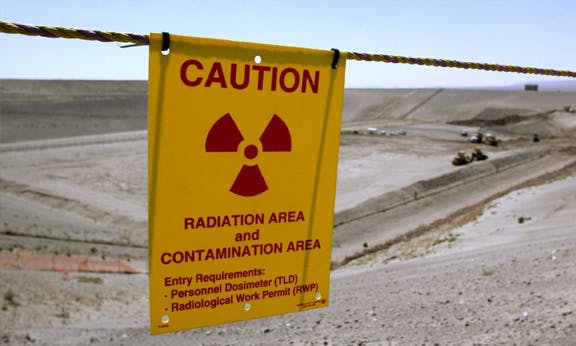South Australia to become global nuclear waste capital

Sixty years ago, Maralinga went up in a mushroom cloud. The British government had been given permission to test atomic weaponry in South Australia.
That is to say, they had been given permission by the right wing Menzies government. The local Maralinga Tjarutja people had no say in it at all. Many of them were not even forewarned of the first blast. Thunderous black clouds condemned them to radiation exposure, illness and death, the survivors being driven from their homeland during the long years of British testing and fallout.
South Australia has a dark history with the nuclear industry. Maralinga remains contaminated, despite cheap clean-up efforts. Uranium tailings have leaked from BHP’s Olympic Dam mine at Roxby Downs. Fukushima’s reactors held South Australian uranium when catastrophe struck in 2011.
Weatherill, aware of most people’s instinctive and rightful mistrust of anything nuclear, has launched a meticulous, expensive PR campaign.Today, Jay Weatherill’s state Labor government is trying to open a new radioactive chapter. He wants South Australia to construct the world’s first international high-level nuclear waste dump. This would mean no fewer than 138,000 tonnes of waste (one-third of the world’s total) being shipped from the world’s reactors into South Australian ports, to be permanently buried in Aboriginal land.
This would be history’s largest nuclear dumping operation, and make South Australia the hazardous waste capital of the world.
Weatherill, aware of most people’s instinctive and rightful mistrust of anything nuclear, has launched a meticulous, expensive PR campaign. He is trying to fit a Hello Kitty mask onto Mr Burns.
The propaganda machine was put into motion by the Nuclear Fuel Cycle Royal Commission, at a cost of $7.2 million. Headed by Kevin Scarce, a former naval officer and South Australian governor, the commission imagines a lip-licking profit to be made by importing and burying the waste. It also recommends expanding uranium mining and laying the groundwork for nuclear power generation.
To soothe concerns, the government is periodically erecting “Know Nuclear” stalls across the state. These stalls spread misinformation. For instance, the government pamphlet “What is Radiation?” boasts that bananas contain potassium-40, a low-level radionuclide found in nature. But they make no comparison to human-made fission products such as strontium-90, which releases almost 20 million times more radiation than your friendly fruity isotope.
In August, more than 150 high school students were whisked to a secretly organised forum about the future of nuclear industry in the state. Secrecy was justified by the suggestion that violent anti-nuclear protesters might endanger the pupils.
Why does the state need to pour such big bucks into this festival of confusing roadshows, misleading science, TV ads and youth re-education sessions? Because most people who know anything about nuclear waste will recognise the danger posed by the proposed dump.
We live in a country in which black lung disease has re-emerged. Mining companies, in a world of competition, refuse to pay for basic safety measures to prevent excessive coal dust inhalation. This logic of cutting costs infuses all business under capitalism; nuclear waste dumps are no exception. As the MUA correctly stated: “Maritime workers – seafarers and wharfies – will be the first exposed to this toxic waste … Nowhere on this planet has a country designed a safe repository for nuclear waste”.
Indeed, the most technologically advanced repositories in the world, no matter how deep underground, have failed. Over many years, German radioactive waste had been disposed of in a deep facility in Lower Saxony. In 2008, it was discovered that some of the 126,000 barrels of waste had been leaking into ground water for decades. In 2014, New Mexico’s Waste Isolation Pilot Plant suffered a burst drum, contaminating the whole facility, including ventilation and surrounding air. Soon after, workers at the plant tested positive for radiation exposure.
This is the most hazardous waste ever produced by industry or the military. The royal commission explains that this stuff “requires isolation from the environment for many hundreds of thousands of years”. That makes the Roman Empire seem like yesterday; it is longer than the human race has existed.
Moreover, previous projects have involved only national waste storage; to transport waste by sea to an international dump has never been attempted and involves multiple dangers of accidental spillage.
Ultimately, this dump is about helping the global nuclear industry. The current build-up of site-by-site waste acts as a brake on investment. They want somewhere to dump it forever so they can go on producing more of it.